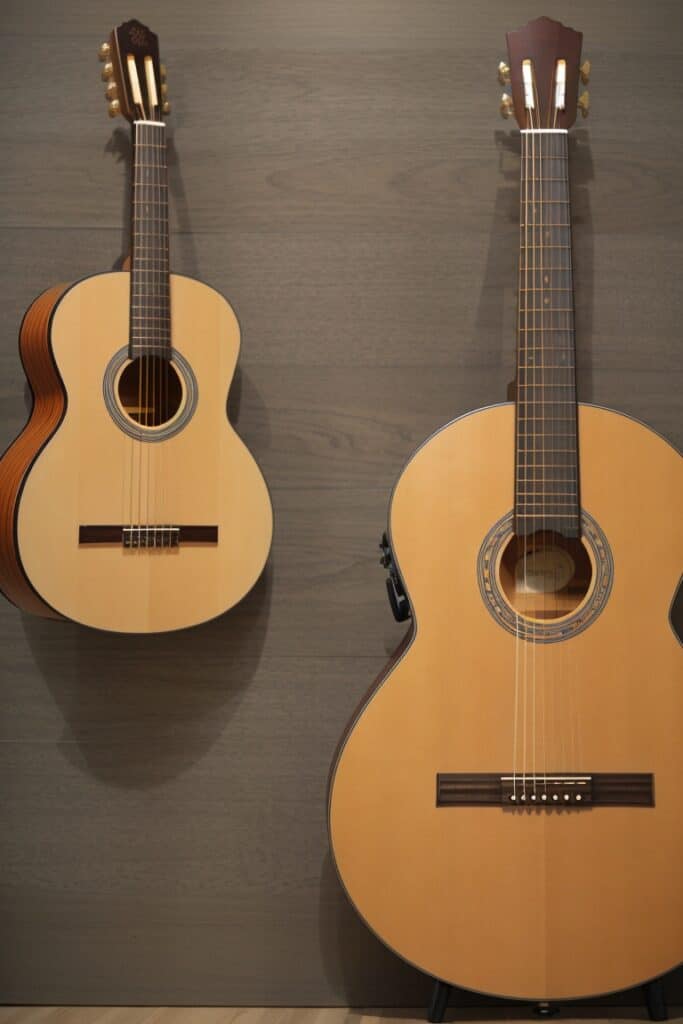Has the question “which is harder to learn: classical or acoustic guitar?” ever made you stand in front of a guitar store, scratching your head, eyes darting between the nylon and steel string acoustic guitars, pondering, “which type of guitar will lead me into a realm of musical ecstasy… or frustration?” If so, you’re not alone! The ‘Classical vs. Acoustic’ debate is as old as the question, “Why did the chicken cross the road?” (we’re still waiting for a satisfying answer to that one too!).
Getting to Know the Contenders: Classical and Acoustic Guitars

Before we go any further, let’s familiarize ourselves with our contenders. The classical guitar, often found in the realm of classical music, with its hollow body, wider neck, and softer nylon strings, parades around like the sophisticated aristocrat of the guitar world. Imagine it as the tuxedo-clad James Bond of instruments—smooth, versatile, and somewhat intimidating.
On the other hand, most acoustic guitars, especially the acoustic steel string guitar, with its slim neck and robust steel strings, are the jeans-and-t-shirt-wearing, all-rounder friends that you love to hang out with. These are the ones you’d take camping or to a bonfire, ready to strum chords and belt out favorite songs with a touch of rock music.
Technique: The Finger-Numbing Battle

Now, let’s talk about the technique involved in playing each type of guitar. With a classical guitar, you’re expected to do fingerstyle picking, using the nails of your right hand. It’s like being asked to juggle while riding a unicycle on a tightrope. The coordination required to play classical guitar might be a bit challenging at first, but with practice, you’ll get the hang of it!
On the contrary, when playing an acoustic guitar, you have the option to use a pick or your fingers. This might seem easier to play, especially if you’re new to learning the guitar.
Music Theory: The Bane of Your Existence?
Music theory in classical guitar can be as confusing as understanding the plot of Inception after the first watch. It’s heavy on scales, arpeggios, and complicated chord shapes, which could make learning classical guitar seem daunting at first. Meanwhile, the acoustic guitar allows you to dip your toes into various music genres without throwing you headfirst into the deep end. It’s a bit like the difference between taking a stroll in the park versus trying to navigate your way through a corn maze.
Repertoire: The Sounds of Your Soul
The repertoire or types of music you’ll play on each guitar also factors into the complexity. With classical, you’ll be interpreting complex pieces composed centuries ago by guys like Bach, who were clearly into crafting beautiful music. On the acoustic, you’ve got everything from The Beatles to Ed Sheeran. Both require skill, but the acoustic has the reputation for being more accessible than the classical guitar.
So, Which One’s Harder? The Classical vs. Acoustic Showdown
So, which is harder to play, the classical or acoustic guitar? The answer, my dear guitar-strumming enthusiasts, is subjective. If you’re someone who’s comfortable diving into a bit of complexity and loves the sounds of classical guitar music, then you might find the classical guitar more challenging but also more rewarding.
On the other hand, if you want to strum chords to some popular songs and create music that’s immediately recognizable to most people, the acoustic steel-string guitar might be your weapon of choice.
Choosing Your First Guitar: An Important Decision

Picking your first type of guitar can be likened to making a significant life decision. It needs to align with your personality, meet your comfort needs, and most crucially, help you produce the kind of music that you aspire to create.
Consider the classical guitar: it might appear a bit daunting at first. With its wide neck and softer nylon strings, it requires a solid understanding of music theory and an affinity for classical compositions. But once you get a handle on it, you’ll find yourself creating mellow, pleasing melodies and mastering the intricacies of fingerstyle playing – it’s truly a rewarding process.
On the other hand, the acoustic steel-string guitar has a unique appeal. It’s versatile, welcoming both pick and finger-style playing, and is flexible enough to support a diverse range of music genres – from pop and country music to rock. While it might not come with the classical guitar’s exacting demands, it nonetheless offers a unique allure that keeps acoustic guitarists engaged and motivated to play more.
Chasing Perfection: Practice Makes Perfect
Learning any stringed instrument can be a challenge. But remember this, practice is your trusty steed in this pursuit. Whether you opt for the classical or the acoustic, consistent practice is the secret sauce to mastering either.
In the classical realm, you might need to practice scales, arpeggios, and fingerstyle techniques till your fingers start questioning your life choices. But let me tell you, the day you flawlessly execute a piece of classical guitar music by Fernando Sor, you will feel astounding!
With the acoustic steel-string guitar, your practice sessions might be filled with chord progressions, strumming patterns, and yes, those pesky F and B barre chords that seem to have been invented as some form of cruel punishment. But hey, when you finally strum through “Wonderwall” without fumbling, you’ll feel on top of the world!
Endurance Training: Building Your Guitar Stamina
Now, a quick note on the physical difficulties of guitar playing. If you thought that learning a musical instrument was all about mental prowess, well, it’s time to recognize the athletic event of guitar playing!
In the left corner, we’ve got the classical guitar, complete with its wide neck and softer nylon strings. This type of guitar can feel like a yoga session for your hand – you might struggle initially with the wider neck, but with time, you’ll gain flexibility and finger strength. This is something every classical guitar player has to overcome.
And in the right corner, the steel string acoustic guitar. Those steel strings can feel like they’re engaged in a personal vendetta against your fingertips. But don’t worry, after a while, your fingers will develop calluses, turning them into tiny, guitar-playing Terminators. That’s the path of learning acoustic guitar.
Classical Vs. Acoustic: Battle of the Genres
Alright, let’s dive a little deeper into the realms of classical and acoustic guitar music. Now, if you’ve ever stumbled upon a heated internet forum debate about different guitar types and music genres, you’d think it was a superhero showdown. Classical guitarists with their complex fingerstyle technique on one side, and acoustic guitarists strumming powerful chords on the other.
To Read or Not To Read: That is the Question

When it comes to reading sheet music, classical guitar is like that one overachieving kid in class who always raises their hand. Classical guitarists rely heavily on reading standard notation for those intricate pieces. It’s part of the process to learn classical guitar.
The acoustic guitar, meanwhile, is like the laid-back kid in the back row, content with reading tabs and chord diagrams. That’s not to say you can’t learn standard notation on an acoustic, but it’s not as central to playing acoustic guitar music.
But remember, no matter which type of guitar you choose, learning to read music will only enhance your skills and understanding of music theory. Whether it’s pop music, rock music, or classical music, each genre has its own set of challenges and rewards. Keep practicing and playing music, and you’ll see your efforts bear fruit.
Which Path Will You Strum Down: Choosing Your Melodic Journey
After comparing the complexities of learning to play classical or acoustic guitar, you might be pondering, “What’s the ultimate decision? Which one is more challenging?” Well, it’s not just about what’s harder to learn, it’s also about the type of music you are truly interested in.
If your soul resonates with the melodies of Bach or Tarrega, if you dream of crafting those elaborate tunes, then learning classical guitar could be your call. It might look somewhat daunting, considering all the fingerstyle techniques and the need to read sheet music. But always remember, the panorama from the summit, especially when you successfully play a classical guitar piece, is absolutely worth it.
However, if your heartbeat syncs to the rhythm of popular songs, country music, or rock anthems, then strumming an acoustic guitar might be your destiny. Granted, those steel strings could seem like a stamina test for your fingertips. Still, when you finally strum in harmony with your favorite songs on your acoustic guitar, it feels like a victory lap – utterly exhilarating.
So there we have it! The journey of learning to play guitar, whether classical or acoustic, is a melodic symphony of triumphs and challenges. It’s a path that demands perseverance, patience, and a profound love for music. But before we conclude, let’s touch upon some valuable tips on purchasing your new guitar and learning to play it.
Embarking on Your Musical Adventure: Starting Your Guitar Journey
So you’ve made your decision and chosen the path you want to tread – classical or acoustic guitar. But wait, don’t rush to your nearest music store just yet. It’s akin to buying a new car – you wouldn’t simply grab the first one you see, would you?
Before you dive headfirst into purchasing a guitar, take a moment to contemplate your options. Conduct your research, and most crucially, remember the golden rule of guitar buying – always try before you buy!
Remember, the price tag doesn’t always reflect the quality or the sound difference of a guitar. So don’t let those shiny, expensive models intimidate you. Think about it, do you reckon Jimi Hendrix kickstarted his journey with a high-end Fender Stratocaster? Absolutely not!
Your New Best Friend: Sailing through Guitar Practice Sessions

The moment has arrived. Your gleaming new guitar is sitting in the corner, all tuned up and ready. It’s time to dive headfirst into practicing. This phase is akin to beginning a new fitness regime – the initial excitement brims over, but as days turn into weeks, that enthusiasm might wane. I urge you, don’t throw in the towel! Learning to play the guitar isn’t just a tally of hours logged. It’s about the productive quality of those hours. Set attainable goals, monitor your progress, and most importantly, derive pleasure from the journey!
Conclusion
The process of learning guitar, be it classical or acoustic, parallels a roller coaster ride – filled with thrills, apprehensions, and a lot of loop-de-loops. Yet, the sensation of accomplishment you encounter at the journey’s end is incomparable. And remember, in the realm of learning, ‘hard’ morphs into ‘distinct’. So whether you gravitate towards classical or acoustic, embrace the hurdles, revel in the triumphs, and let the melody be your guide. Ultimately, the level of difficulty isn’t the essential aspect of learning to play guitar. What truly matters is what captivates your interest and what can sustain your motivation throughout the long, meticulous hours necessary to master this captivating new instrument. So go forth, grab that guitar, and embark on your melodious journey. Believe me, it’s going to be a euphonious ride. Here’s wishing you many hours of blissful strumming!
Frequently Asked Questions
1. Is learning classical guitar harder than learning acoustic guitar? This often depends on personal preferences and musical background. While classical guitar may seem more challenging due to its fingerstyle technique and complex pieces, acoustic guitar has its challenges too, such as mastering strumming patterns and chord progressions. It boils down to what style of music you are more drawn to and how much effort you’re willing to put into your practice.
2. Which guitar should I choose as a beginner? As a beginner, your choice of guitar should align with your musical interests. If you’re drawn to rock, pop, or folk music, an acoustic guitar might be the best choice. If you’re interested in classical music or flamenco, a classical guitar would be more suitable. It’s crucial to pick a guitar that resonates with your musical tastes, as it can keep you motivated throughout your learning journey.
3. Is it possible to learn both classical and acoustic guitar? Absolutely! Many guitarists play both classical and acoustic guitar. Understanding the techniques and styles of both can make you a more versatile player. However, it might be best to start with one and get comfortable with it before moving on to the other.
4. I’ve chosen my guitar. What’s next? Once you’ve chosen your guitar, it’s time to start practicing! Create a regular practice schedule and stick to it. Remember, quality over quantity. Engaging, mindful practice is far more effective than mindless hours of repetition.
5. What are some common challenges I might face as a beginner? Some common challenges beginner guitarists face include building finger strength, mastering chord transitions, and reading music or tabs. It’s crucial to be patient with yourself during this process. Every guitarist, even the greats, started where you are now.
6. Can I self-teach, or do I need a teacher to learn guitar? While many guitarists are self-taught, having a teacher, at least in the beginning, can be beneficial. They can provide structured lessons, correct your mistakes, and give you feedback. Once you’ve got the basics down, you can decide whether to continue with a teacher or go the self-taught route.
7. How long will it take for me to play my first song? This depends on various factors, including the difficulty of the song, your practice schedule, and your quickness in picking up new skills. However, with consistent practice, you could start playing simple songs within a few weeks.Top of Form
